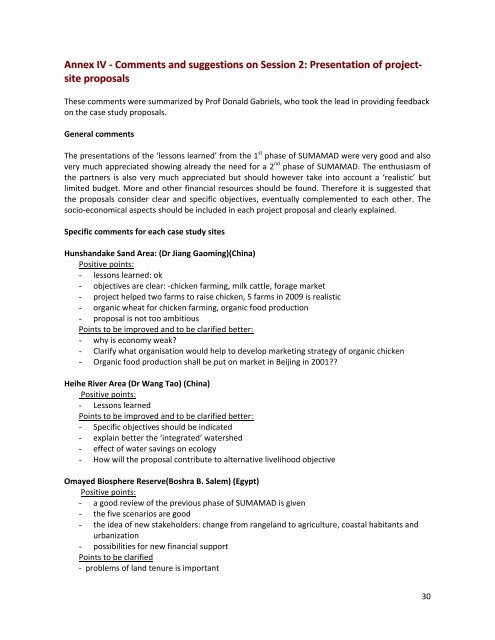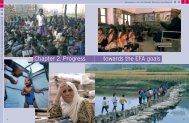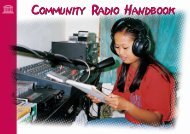Planning Workshop –Sustainable Management of Marginal - Unesco
Planning Workshop –Sustainable Management of Marginal - Unesco
Planning Workshop –Sustainable Management of Marginal - Unesco
You also want an ePaper? Increase the reach of your titles
YUMPU automatically turns print PDFs into web optimized ePapers that Google loves.
Annex IV ‐ Comments and suggestions on Session 2: Presentation <strong>of</strong> project‐<br />
site proposals<br />
These comments were summarized by Pr<strong>of</strong> Donald Gabriels, who took the lead in providing feedback<br />
on the case study proposals.<br />
General comments<br />
The presentations <strong>of</strong> the ‘lessons learned’ from the 1 st phase <strong>of</strong> SUMAMAD were very good and also<br />
very much appreciated showing already the need for a 2 nd phase <strong>of</strong> SUMAMAD. The enthusiasm <strong>of</strong><br />
the partners is also very much appreciated but should however take into account a ‘realistic’ but<br />
limited budget. More and other financial resources should be found. Therefore it is suggested that<br />
the proposals consider clear and specific objectives, eventually complemented to each other. The<br />
socio‐economical aspects should be included in each project proposal and clearly explained.<br />
Specific comments for each case study sites<br />
Hunshandake Sand Area: (Dr Jiang Gaoming)(China)<br />
Positive points:<br />
- lessons learned: ok<br />
- objectives are clear: ‐chicken farming, milk cattle, forage market<br />
- project helped two farms to raise chicken, 5 farms in 2009 is realistic<br />
- organic wheat for chicken farming, organic food production<br />
- proposal is not too ambitious<br />
Points to be improved and to be clarified better:<br />
- why is economy weak?<br />
- Clarify what organisation would help to develop marketing strategy <strong>of</strong> organic chicken<br />
- Organic food production shall be put on market in Beijing in 2001??<br />
Heihe River Area (Dr Wang Tao) (China)<br />
Positive points:<br />
- Lessons learned<br />
Points to be improved and to be clarified better:<br />
- Specific objectives should be indicated<br />
- explain better the ‘integrated’ watershed<br />
- effect <strong>of</strong> water savings on ecology<br />
- How will the proposal contribute to alternative livelihood objective<br />
Omayed Biosphere Reserve(Boshra B. Salem) (Egypt)<br />
Positive points:<br />
- a good review <strong>of</strong> the previous phase <strong>of</strong> SUMAMAD is given<br />
- the five scenarios are good<br />
- the idea <strong>of</strong> new stakeholders: change from rangeland to agriculture, coastal habitants and<br />
urbanization<br />
- possibilities for new financial support<br />
Points to be clarified<br />
‐ problems <strong>of</strong> land tenure is important<br />
30

















